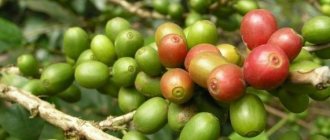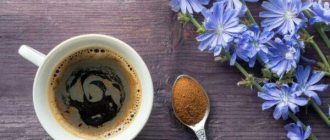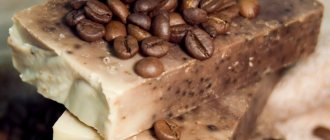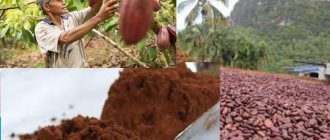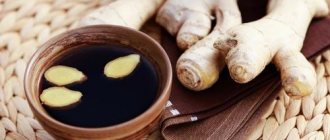Coffee is one of the most delicious drinks; it is prepared from pre-ground and roasted coffee beans. The caffeine contained in these beans has an invigorating effect on the human body. This “elixir of life” contains a bitter taste, and in order to moderate it, various additives are included in the drink, among which condensed milk is extremely popular. However, coffee with condensed milk has one distinctive feature - it is significantly higher in calories than ordinary espresso. Of course, you can add plain cow's milk to your coffee, but big sweet lovers prefer condensed milk.
Varieties according to bioindicators
There are many classifications of this drink. However, we will take as a basis the sorting depending on the type of plant from which the grains are taken. Typically, Arabica, Robusta and Liberica determine the varieties of coffee.
Arabian coffee
The leading position is taken by Arabica - a small tree that produces wonderful fragrant fruits of excellent quality, but is very picky and less prolific than Robusta. It is Arabica that gives the drink a special rich aroma, an attractive light taste and an excellent golden foam. The beans of this type are large, uneven, and contain approximately 1-1.5% caffeine.
How many calories are in coffee with condensed milk?
Nutritional value and chemical composition of “Instant coffee with condensed milk.”
The table shows the nutritional content (calories, proteins, fats, carbohydrates, vitamins and minerals) per 100 grams of edible portion.
| Nutrient | Quantity | Norm** | % of the norm in 100 g | % of the norm in 100 kcal | 100% normal |
| Calorie content | 24.7 kcal | 1684 kcal | 1.5% | 6.1% | 6818 g |
| Squirrels | 0.6 g | 76 g | 0.8% | 3.2% | 12667 g |
| Fats | 0.6 g | 56 g | 1.1% | 4.5% | 9333 g |
| Carbohydrates | 4.2 g | 219 g | 1.9% | 7.7% | 5214 g |
| Water | 94 g | 2273 g | 4.1% | 16.6% | 2418 g |
| Ash | 0.284 g | ~ | |||
| Vitamins | |||||
| Vitamin A, RE | 3.3 mcg | 900 mcg | 0.4% | 1.6% | 27273 g |
| Retinol | 0.003 mg | ~ | |||
| beta carotene | 0.002 mg | 5 mg | 250000 g | ||
| Vitamin B1, thiamine | 0.004 mg | 1.5 mg | 0.3% | 1.2% | 37500 g |
| Vitamin B2, riboflavin | 0.027 mg | 1.8 mg | 1.5% | 6.1% | 6667 g |
| Vitamin B4, choline | 2.09 mg | 500 mg | 0.4% | 1.6% | 23923 g |
| Vitamin B5, pantothenic | 0.057 mg | 5 mg | 1.1% | 4.5% | 8772 g |
| Vitamin B6, pyridoxine | 0.009 mg | 2 mg | 0.5% | 2% | 22222 g |
| Vitamin B12, cobalamin | 0.035 mcg | 3 mcg | 1.2% | 4.9% | 8571 g |
| Vitamin C, ascorbic acid | 0.07 mg | 90 mg | 0.1% | 0.4% | 128571 g |
| Vitamin D, calciferol | 0.003 µg | 10 mcg | 333333 g | ||
| Vitamin E, alpha tocopherol, TE | 0.014 mg | 15 mg | 0.1% | 0.4% | 107143 g |
| Vitamin H, biotin | 0.223 mcg | 50 mcg | 0.4% | 1.6% | 22422 g |
| Vitamin RR, NE | 0.3451 mg | 20 mg | 1.7% | 6.9% | 5795 g |
| Niacin | 0.014 mg | ~ | |||
| Macronutrients | |||||
| Potassium, K | 53.37 mg | 2500 mg | 2.1% | 8.5% | 4684 g |
| Calcium, Ca | 25.14 mg | 1000 mg | 2.5% | 10.1% | 3978 g |
| Magnesium, Mg | 6.09 mg | 400 mg | 1.5% | 6.1% | 6568 g |
| Sodium, Na | 12.79 mg | 1300 mg | 1% | 4% | 10164 g |
| Sera, S | 4.88 mg | 1000 mg | 0.5% | 2% | 20492 g |
| Phosphorus, P | 18.1 mg | 800 mg | 2.3% | 9.3% | 4420 g |
| Chlorine, Cl | 16.6 mg | 2300 mg | 0.7% | 2.8% | 13855 g |
| Microelements | |||||
| Iron, Fe | 0.051 mg | 18 mg | 0.3% | 1.2% | 35294 g |
| Yod, I | 0.49 mcg | 150 mcg | 0.3% | 1.2% | 30612 g |
| Cobalt, Co | 0.14 mcg | 10 mcg | 1.4% | 5.7% | 7143 g |
| Manganese, Mn | 0.0145 mg | 2 mg | 0.7% | 2.8% | 13793 g |
| Copper, Cu | 12.33 mcg | 1000 mcg | 1.2% | 4.9% | 8110 g |
| Selenium, Se | 0.302 mcg | 55 mcg | 0.5% | 2% | 18212 g |
| Fluorine, F | 2.44 mcg | 4000 mcg | 0.1% | 0.4% | 163934 g |
| Zinc, Zn | 0.0791 mg | 12 mg | 0.7% | 2.8% | 15171 g |
| Digestible carbohydrates | |||||
| Mono- and disaccharides (sugars) | 3.9 g | max 100 g | |||
| Lactose | 0.872 g | ~ | |||
| Sucrose | 3.035 g | ~ | |||
| Essential amino acids | 0.198 g | ~ | |||
| Arginine* | 0.017 g | ~ | |||
| Valin | 0.032 g | ~ | |||
| Histidine* | 0.012 g | ~ | |||
| Isoleucine | 0.029 g | ~ | |||
| Leucine | 0.038 g | ~ | |||
| Lysine | 0.038 g | ~ | |||
| Methionine | 0.012 g | ~ | |||
| Methionine + Cysteine | 0.016 g | ~ | |||
| Threonine | 0.021 g | ~ | |||
| Tryptophan | 0.007 g | ~ | |||
| Phenylalanine | 0.022 g | ~ | |||
| Phenylalanine+Tyrosine | 0.046 g | ~ | |||
| Nonessential amino acids | 0.315 g | ~ | |||
| Alanin | 0.016 g | ~ | |||
| Aspartic acid | 0.037 g | ~ | |||
| Glycine | 0.01 g | ~ | |||
| Glutamic acid | 0.111 g | ~ | |||
| Proline | 0.054 g | ~ | |||
| Serin | 0.029 g | ~ | |||
| Tyrosine | 0.024 g | ~ | |||
| Cysteine | 0.005 g | ~ | |||
| Sterols (sterols) | |||||
| Cholesterol | 2.09 mg | max 300 mg | |||
| Saturated fatty acids | |||||
| Saturated fatty acids | 0.4 g | max 18.7 g | |||
| 16:0 Palmitinaya | 0.001 g | ~ | |||
| Monounsaturated fatty acids | 0.18 g | min 16.8 g | 1.1% | 4.5% | |
| 18:1 Oleic (omega-9) | 0.172 g | ~ | |||
| Polyunsaturated fatty acids | 0.024 g | from 11.2 to 20.6 g | 0.2% | 0.8% | |
| 18:2 Linolevaya | 0.014 g | ~ | |||
| 18:3 Linolenic | 0.004 g | ~ | |||
| 20:4 Arachidonic | 0.006 g | ~ | |||
| Other substances | |||||
| Caffeine | 24.186 mg | ~ |
Nutritional value of the product
For 100 grams of coffee with condensed milk, the calorie content ranges from 55 to 105 kcal (maybe more - it all depends on the amount of condensed milk added).
Now about the nutritional value. The drink has the following ratio of macroelements:
- Proteins: 6.30 g.
- Fat: 10.50 g.
- Carbohydrates: 10 g.
Useful properties of the drink
Espresso has a stimulating effect, and with the addition of condensed milk it normalizes the functioning of the nervous system. The grains of this delicious treat contain serotonin, the so-called “happiness hormone”. It helps lift your mood and fight depression.
Application
Coffee has been enjoyed with pleasure for several centuries. It is worth remembering that it is better to drink coffee in the morning - the drink will give you the boost of energy necessary for productive activities.
According to the Eastern tradition of drinking coffee, you need to drink a coffee drink after a hearty breakfast. Because coffee drunk on an empty stomach can harm the body. Confectioners and producers of alcoholic beverages enjoy using aromatic coffee beans, which makes their products especially memorable and popular.
Market Analytics
- 10 most revolutionary scientific developments in the beauty industry in 2021
- Top 10 Best Beauty Products in 2022
- Global cosmetics market 2022: an unprecedented test for the global cosmetics industry
Convenient search for beauty salons on our website
Beauty salons in Moscow Beauty salons in St. Petersburg Beauty salons in Ekaterinburg Beauty salons in Novosibirsk
Latest blog posts on our website
- Naturecream / Properties of the “Sunny” oil itself
- Naturecream / “Sugar” wrinkles - or what glycation can do
- Naturecream / Esterified oils
- Naturecream / Arnica - the magical plant of alchemists
- Naturecream / Tremella Extract - Snow Mushroom Detox for Skin
- Prostye-sovety / How to visually enlarge your lips with makeup
- Naturecream / Apricot kernel oil for face
- Naturecream / MATRIXYL3000 - the best skin elasticity stimulator
- Naturecream / SPF in Natural Oils
- Naturecream / Geranium (Pelargonium) oil for skin health and beauty
Latest forum topics on our website
- Natalya / How to properly make a gelatin mask?
- Mrs._Smith / Badly sunburned! What to do?((
- Ice / Is it necessary to combine fitness classes with a diet?
- Antonova / What can be used for hair loss?
- Radio operatorKat / Who was on a protein diet?
Other articles in this section
| Water Water (otherwise hydrogen oxide, chemical formula H2O) - under normal conditions it is a transparent liquid that in a small volume has no taste, smell or color. Water, depending on conditions, can acquire three states: liquid, solid and gaseous. |
| Quince juice Quince is the only representative of a monotypic genus of woody shrubs belonging to the Rosaceae family. It grows in Transcaucasia and Central Asia, as well as in Mediterranean countries, where in ancient times it was considered one of the symbols of love and fertility. The flowering period lasts from May to June, the fruits ripen at the end of September. Despite their external resemblance to apples, fresh quince fruits have a characteristic edge; they are very hard and tart. |
| Pear juice Pear belongs to the common fruit garden crops of the Rosaceae family. In ancient times, pears were cultivated in Persia, Ancient Greece and Rome. Today, this crop is grown to produce juicy and aromatic fruits in many European countries, India, and China. Russia. Pear fruits are among the most popular fruits in many countries due to their aroma, pleasant, sweet taste and beneficial properties. |
| Peach juice For many centuries, people believed that the peach, the most delicate and very tasty fruit, comes from Persia. The reason for this was that he arrived in most European countries with caravans of merchants from this country. This opinion lasted until the end of the 19th century. Only a long study of manuscripts by botanists made it possible to discover the true homeland of this fruit. It turned out that the peach, like many fruits, comes from China. Nowadays, it has already been scientifically proven that peach cultivation began for the first time in China. |
| Parsley juice Parsley is a very well-known and popular spicy herb, its history goes back thousands of years. Originally from the Mediterranean, it quickly conquered the whole of Europe. People have used it for both culinary and medicinal purposes since ancient times. Parsley spread throughout the world with the emergence of colonies. Europeans brought seeds of familiar plants with them to new places, thus distributing them throughout the globe. |
| Beetroot juice What could be better than freshly squeezed juices? They are definitely a healthy food! Many people love juices from berries and fruits and know about their beneficial properties, but few have tried vegetable juices, justifying their dislike for them by the fact that they are tasteless, although healthy. And one of them is beet juice. Some people love it, others not so much, but despite differences in tastes, it is one of the healthiest! |
| Cherry juice jelly Many nutritionists advise adding a dish such as jelly to your diet. Its viscous and thick consistency envelops the gastric mucosa and improves many processes of digestion and metabolism in the body. Jelly made from fruits and berries can be included in the diet of infants from the age of eight months, and for older children it is recommended to cook the jelly thicker and add less sugar, which is very harmful to the child’s body. |
| Elderberry juice Black elderberry is a medicinal plant that has many vitamins and microelements, which make it a universal remedy in the fight against colds, decreased immunity, loss of strength, anemia and even hepatitis C. |
| Plum juice Plum juice is not only a tasty and dietary drink, but also very healthy! It has medicinal qualities and is useful for almost everyone. The exception is people who suffer from intestinal disorders. |
| Lingonberry fruit drink is considered a traditional drink of Russian cuisine, known since the 16th century. To prepare lingonberry juice, you need wild lingonberries. The berries can be either fresh or frozen (in this case, you need to completely defrost them first). For 1 liter of fruit drink you will need about 150 g of lingonberries. |
Recipe for an invigorating drink with condensed milk
Here are the required components:
- ground coffee beans – 1 tsp.
- water – 100 ml.
- condensed milk - to taste.
Cooking method:
- Place the crushed coffee beans in a pot and fill with cold water.
- Cook over low heat until done.
- Let the drink brew for a while and pour it into a mug.
- Add condensed milk to the finished coffee. We interfere. If you want, you can add a little sugar.
Condensed milk and coffee - who came up with the idea of combining?
In most cases, coffee with condensed milk is called Vietnamese. Modern Vietnam is a leader in the production of various coffee varieties, and even surpasses Brazil in export volumes. The unusual taste combination appeared at a time when Vietnam was a colony of France: the French brought original ideas to the country.
The Vietnamese drink with condensed milk also has this name because the sweet milk base goes perfectly with Vietnamese coffee varieties. Bitter ground grains are always used as a base to reduce the sweetness of condensed milk.
At one time, the tradition of drinking a bitter cocktail with condensed milk also developed in the countries of the post-Soviet space. Sweet-tasting milk was used as a universal sweetener.
The name itself - Vietnamese coffee - came from America: after the war, many migrants came to the country, and they brought with them unusual traditions - for example, diluting a coffee drink with condensed milk. Before the Vietnamese migrants, Native Americans preferred strong and neat drinks.
The modern recipe differs from the classic one: the drink is served with various additives and toppings. Vietnamese cocktails are sold as a cold drink or as a hot dessert. Both the instant product and ground grains are used as a basis.


